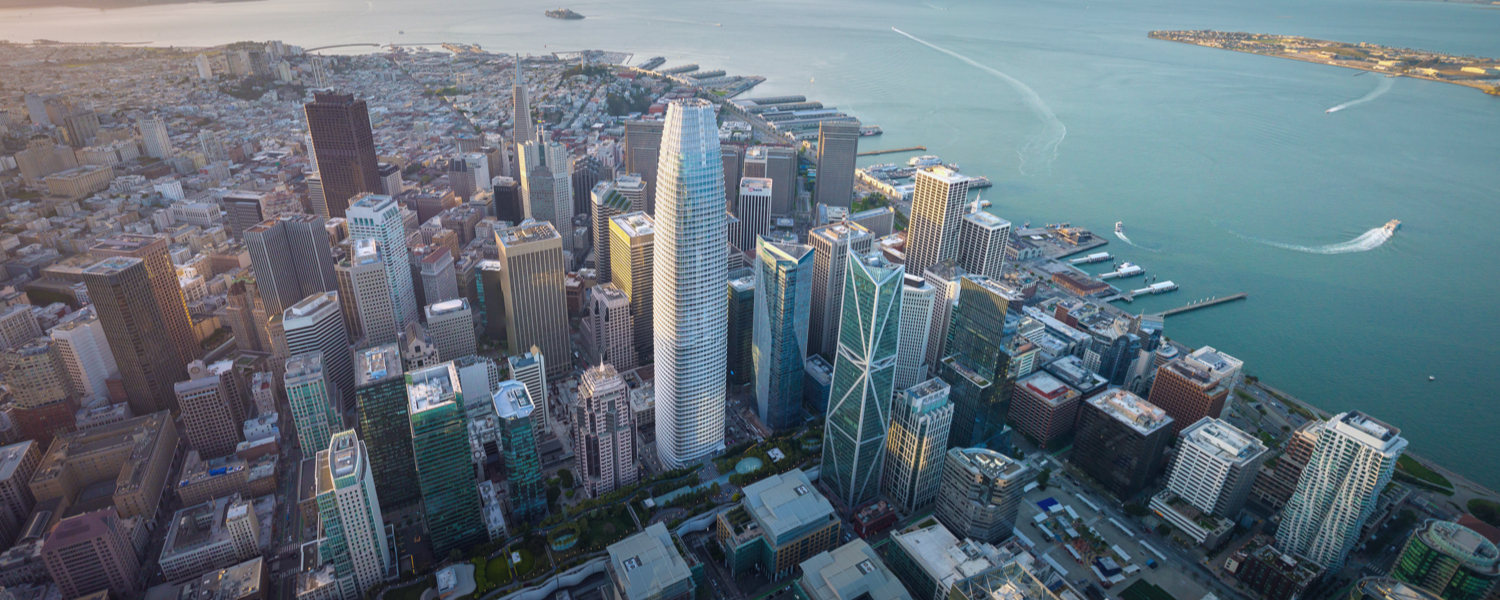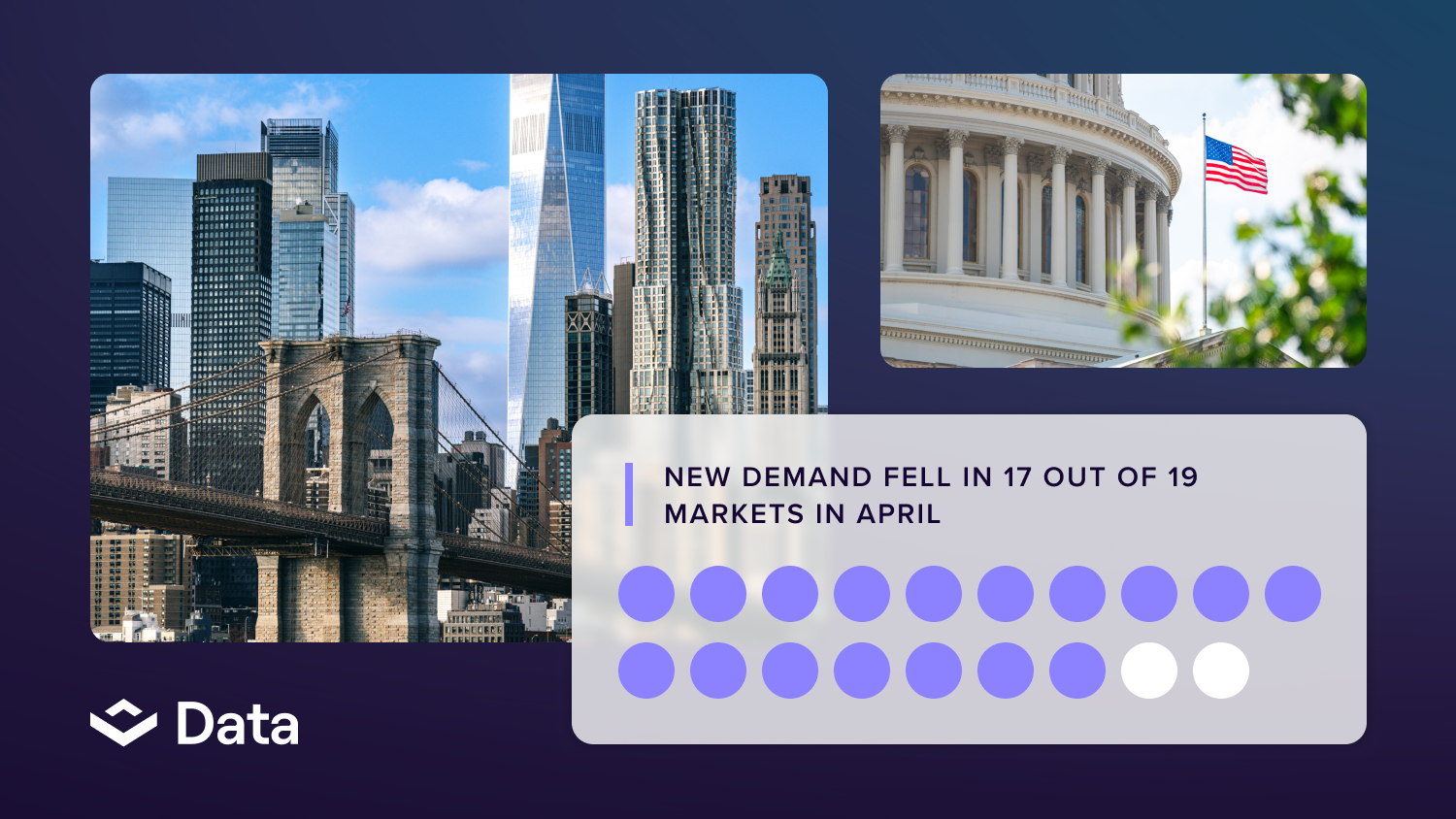Four years after Covid began, downtowns and downtown offices continue to face major challenges.
Currently, office vacancy is high, hybrid schedules remain stubborn, and building values are still in flux. The VTS Office Demand Index, for example, has maintained about half to two-thirds of its pre-pandemic level for the last two years. In addition, transit ridership in most cities remains well below 2019 levels, and many transit agencies face a looming fiscal cliff with the expiration of federal relief funds.
Despite this, there’s good reason for hope.
Transit ridership is increasing, emerging industries are still concentrating in downtown cores, and many cities are embracing creative strategies to attract more people. And office space near high-capacity transit is performing well. VTS research found that buildings within five and ten minute walks of transit hubs recently received significantly more tours than buildings further away, with fewer tours on average the further the walk.
The ace up the sleeve for downtowns is the special role of existing transit infrastructure. Far from crisis, downtowns are actually well-positioned for the future.
Today is different than post-WWII suburbanization
To some, the current challenges of downtown seems comparable to the post-WWII era of suburbanization, when central city populations declined and downtowns’ share of regional office space and jobs plummeted.
At that time, most cities mistakenly embraced the automobile as the solution and allowed highways to tear through neighborhoods, displacing hundreds of thousands of residents, while encircling downtowns with a spaghetti of new roads in what were once viable neighborhoods.
But transit endured, and so did downtowns. Some regions added new transit in subsequent decades, often to prioritize suburban commuters (much to the chagrin of urban residents). And despite decades of suburbanization and prioritization of highway investment, downtowns boomed again. From 2000 to 2010, downtowns in metropolitan regions greater than 1 million grew significantly faster than their surrounding county or metropolitan region, reversing the opposite trend in prior decades.
While some observers cannot see past the current atmosphere and challenges, we believe that history echoes and that the past endurance of downtowns and transit holds some lessons for the future.
A key part of downtowns’ value proposition is transit. The existing transit infrastructure – subways, street cars, light rail, even ferries – built to support commuting to and from the central business district also makes downtown, and particularly buildings near transit, the region’s most accessible place.
That’s good for office owners because you cannot move an office building and you (generally) cannot move a rail line. We believe that over the next several decades, downtowns with significant rail transit infrastructure today will have an enduring advantage that will actually grow over time.
Why?
- First, it’s exceedingly hard to build new transportation infrastructure in the U.S.
- Second, it’s also exceedingly hard to build new dense mixed-use centers. That means downtowns will face fewer competitors.
- Third, downtown transit is key to achieving climate goals as it allows people to get around without driving. Climate priorities are likely to compel policy ever more powerfully in the coming years.
Transit infrastructure gives downtowns and the buildings close to them a huge advantage.
In most metropolitan regions, the place with the greatest transit infrastructure and highest transit ridership is the region’s primary downtown or central business district. This resulted from the concentration of rail lines into downtowns in the early and mid 20th century, including Chicago’s L, the subways under Lower Manhattan, San Francisco’s Ferry Building and street cars up and down Market Street and post WWII BART.
Today, Lower Manhattan has 3 million jobs within a 30 minute transit commute (most of those within Lower Manhattan or Midtown), and Downtown Los Angeles has nearly 1.2 million jobs within 30 minutes. No other place in the region compares.
That transit-driven advantage is likely to persist as downtowns benefit from existing infrastructure, for at least three reasons.
1. Building new transit has become so hard that downtowns’ infrastructure advantage will persist.
In the decade from 2010 to 2019, the United States invested nearly $50 billion into new or expanded transit (for a total of 1,200 additional miles). But this investment did not result in as much new transit as in prior eras.
U.S. transit infrastructure projects take too long to build and cost too much. For example, New York City built two subway extensions in the 2010s (the 2nd Avenue subway and the 7 line extension) for $1.3 to $1.6 billion / km. In the same time period, Paris built several metro extensions for less than a quarter ($250 million/km) while Madrid Metro extensions only cost $85 million/km). In the Bay Area, a long-planned six-mile rail extension into Downtown San Jose on BART saw its projected cost increase from under $5 billion to over $12 billion and an opening date pushed back a decade to 2036.
While the above challenges impact the ability to add new transit, including to downtown, they also mean that US downtowns that are transit-rich today likely won’t face new competitors in the foreseeable future. Today’s downtown transit advantage will have longevity.
2. Location and density matter. Even after decades of suburbanization, there are no real competitors to the mixed-use activity centers of downtowns.
People want places to come together for socialization and economic activity. Location still matters. As does density. Accessible places with transit can support density. This is geometry. You cannot get hundreds of thousands of people daily into a small area without transit.
Within a metropolitan region there are dozens of activity centers. According to research by Brookings Metro, these activity centers account for 3% of land and 40% of jobs. And among these activity centers, major urban downtowns and central business districts stand out as the primary center of activity with an even greater agglomeration of activity and far higher job density than other activity centers. And proximity to these activity centers has significant benefits.
There are simply too few dense walkable neighborhoods. Housing data also shows there is value in walkable areas because they are scarce, and that readily translates to office districts. This plays to the advantage of downtowns which are both the region’s primary centers and often one of the most walkable places. They have no peers regionally.
Unfortunately, our collective slow pace at building new mixed-use centers around transit will also play to the advantage of downtown as they will not be easily replicated.
These first two points about slowness of infrastructure and lack of competitors to the mixed-use nature of downtowns stand in contrast from the post WWII decades where downtowns faced growing competition. Edge Cities with newly built office parks boomed in formerly undeveloped areas on the outskirts of metros in the 1980s. A new geography of Edgeless Cities of office space scattered along highway corridors proliferated in the early 2000s.
Now, those suburban places are congested and often growing in cost. While areas outside of traditional downtowns will continue to accommodate the bulk of jobs and office space, downtown’s transit advantage will create opportunities for healthy infill and therefore attract an outsized share of growth.
3. Our climate commitments will reinforce the need for shared travel and walkability.
The third reason downtown will benefit from the existing transit infrastructure is our growing awareness of and action on climate, especially with the December 2023 COP28 agreement signaling the need to transition away from fossil fuels . Transportation is the largest share of greenhouse gas emissions in the United States. In our densest downtowns, most people arrive on transit, or walking. Driving alone is the exception in Downtown New York, San Francisco, Seattle, and D.C.
Looking ahead, climate considerations will increasingly shape policy. Even with the major push towards electrification, transit still matters. According to the California Air Resources Board, even with the commitment to only sell new electric vehicles in 2035, there is still a need to reduce overall driving by 25% by 2030. Transit is key to reducing driving. And downtowns are the places with the transit that allows our regions and states to meet these climate goals.
What does this mean for the office market?
Office owners need to make sure they perceive the value of downtown office space served by transit correctly.
In the coming years, cities and regions will be compelled to double down on the value of existing transit. They will need to make sure transit keeps running, even as it requires putting more funding into operations. It also means they’ll need to focus on the basics – service frequency, reliability, and cleanliness. Already, in the Bay Area there is talk about consistent and integrated fares to make the experience of navigating across 27 different transit operations feel seamless.
For downtowns, the consequences from Zoom meetings replacing office work are here already. Unlike the past, the main competitor to downtown office demand is the couch, not the suburban office park. At the same time, those suburban job centers face their own reduced demand from hybrid work schedules while struggling with increased congestion (and managing with fewer options for transit commutes).The transportation infrastructure we have in place today will largely be the infrastructure we will have in the future. Functioning transit will allow downtowns to return and continue expanding their value as the most accessible places in the region, and for the widest range of people. Downtown office will retain its value because of its location and accessibility, with transit being key. Despite the current atmosphere, identifying office space whose location and performance is empowered by transit and the strengths of downtown will prove even more important in the future.
Issi Romem and Egon Terplan are contributing authors to VTS. Issi is an economist and the founder of MetroSight. Egon is a Senior Advisor at MetroSight.






